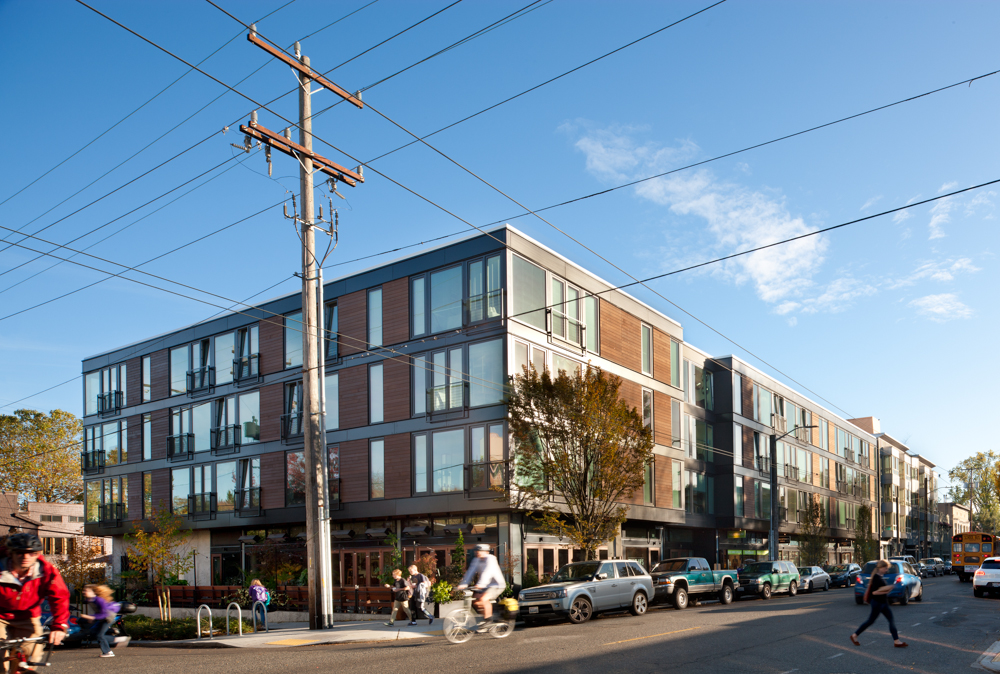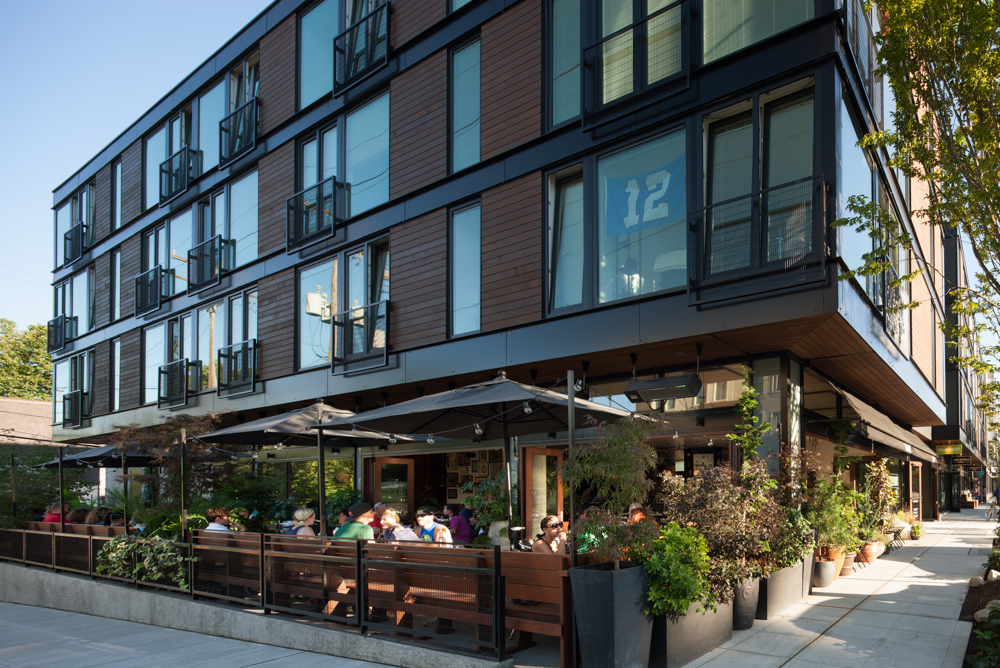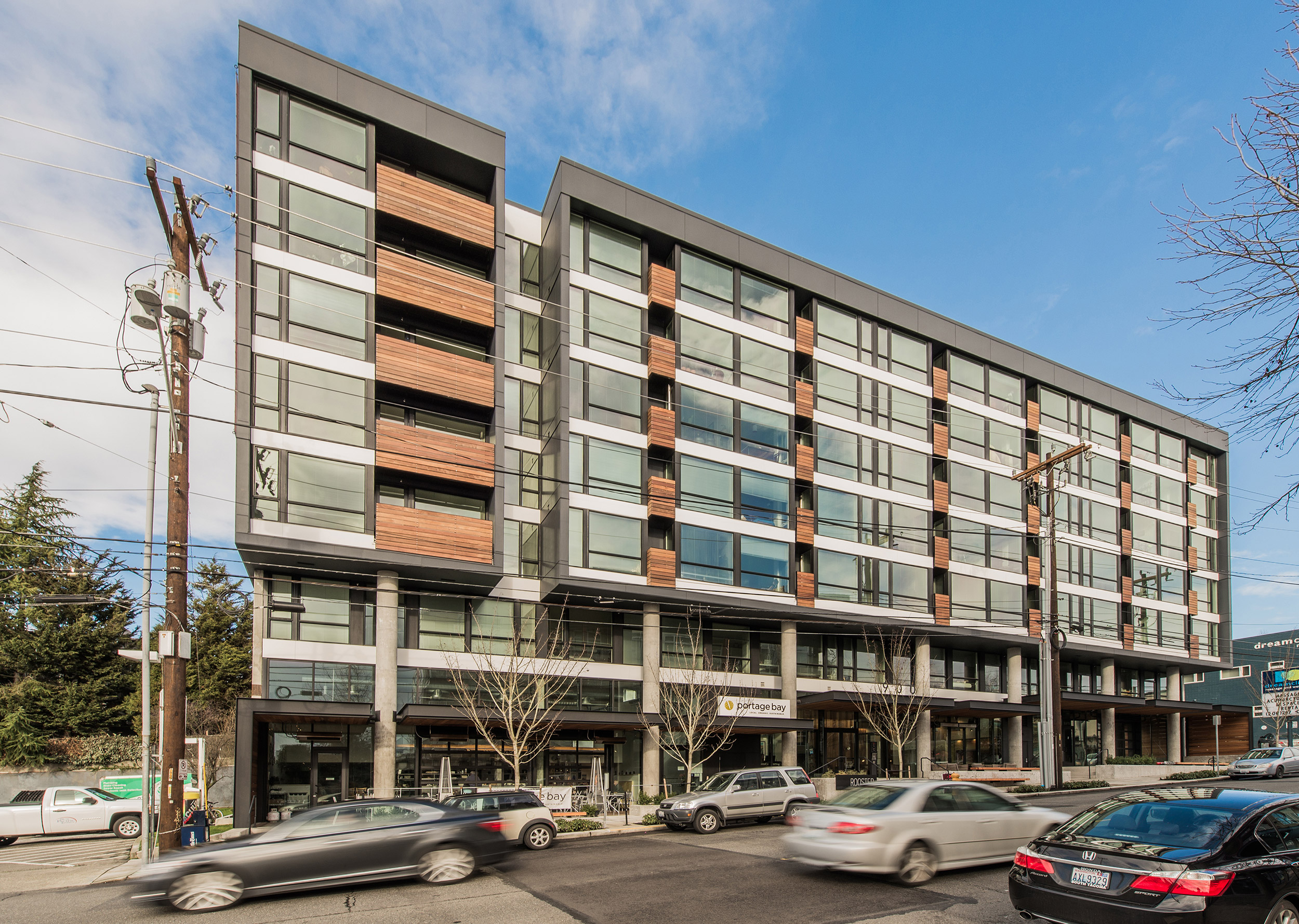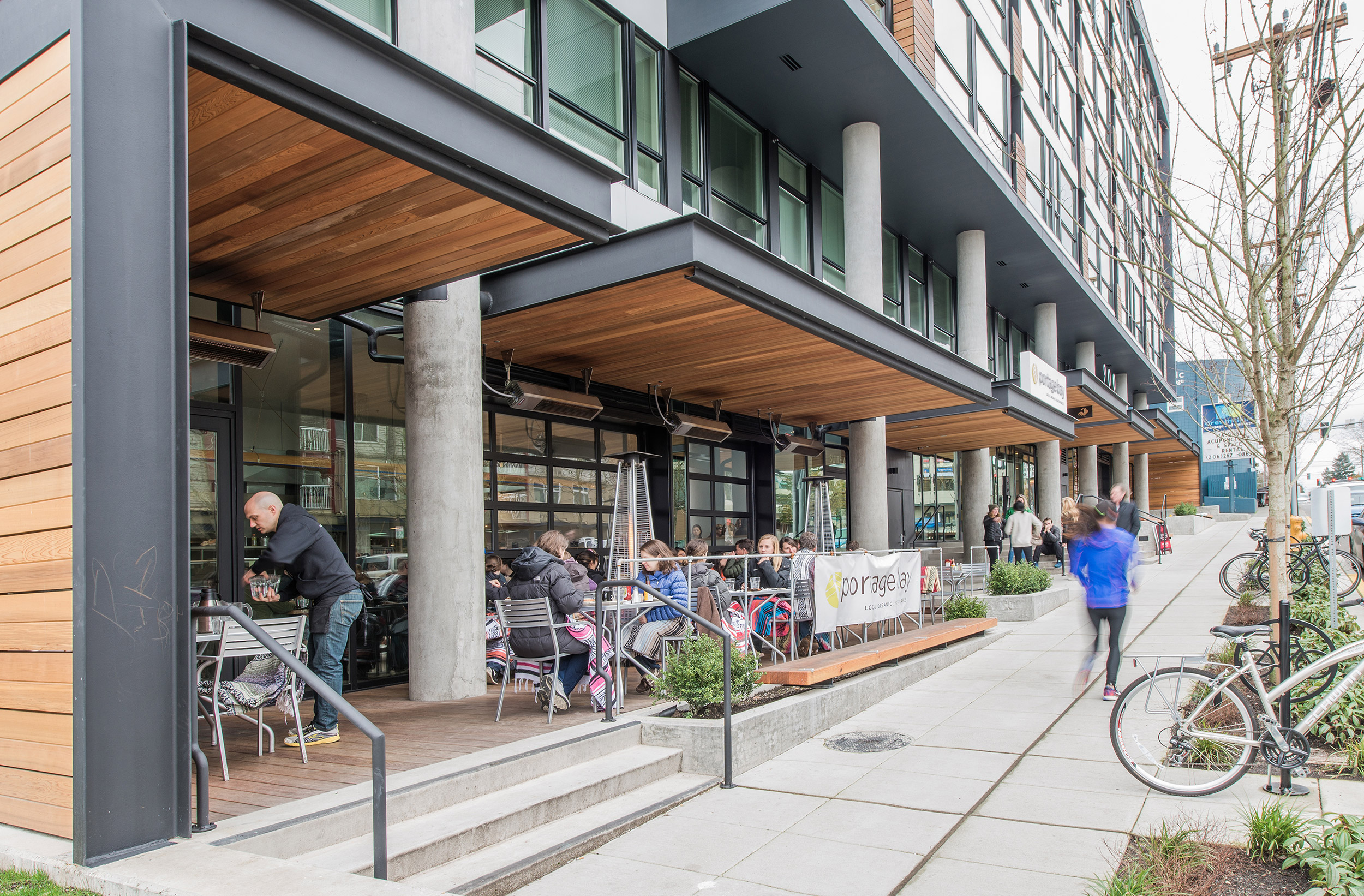
Nearly a decade ago, BUILD met with Joe Ferguson and Pat Foley of the Seattle real estate development firm Lake Union Partners to discuss conscientious development, anchoring neighborhoods, and the challenges of creating affordable urban housing. We hope you enjoy this conversation from our archives. Part 2 can be read here.
Many of your projects are located in marginalized neighborhoods; what concerns have communities had about the potential gentrification produced by your developments?
Pat Foley: When it comes to community commentary, it’s more often about social issues than actual development. The most frequent issue raised in neighborhoods is about access. For instance, with our East Union project, the community was worried we were going to put in a high-end grocery store that the average citizen could not afford. That’s challenging for us because we want to include a store that provides quality and is well designed—at the same time, we can’t set their prices.
Joe Ferguson: I think we’ve identified a market of potential new residents and retail that not only cares about sustainability, but also has a sense of social equity; we work to incorporate the neighborhoods’ values and interests.
Your 19th& Mercer project includes Tallulah’s restaurant [now closed] in its prominent corner retail space, which is owned and operated by Linda Derschang (owner of Linda’s Tavern, King’s Hardware, Smith, Oddfellows, Bait Shop). How did your relationship with Derschang develop?
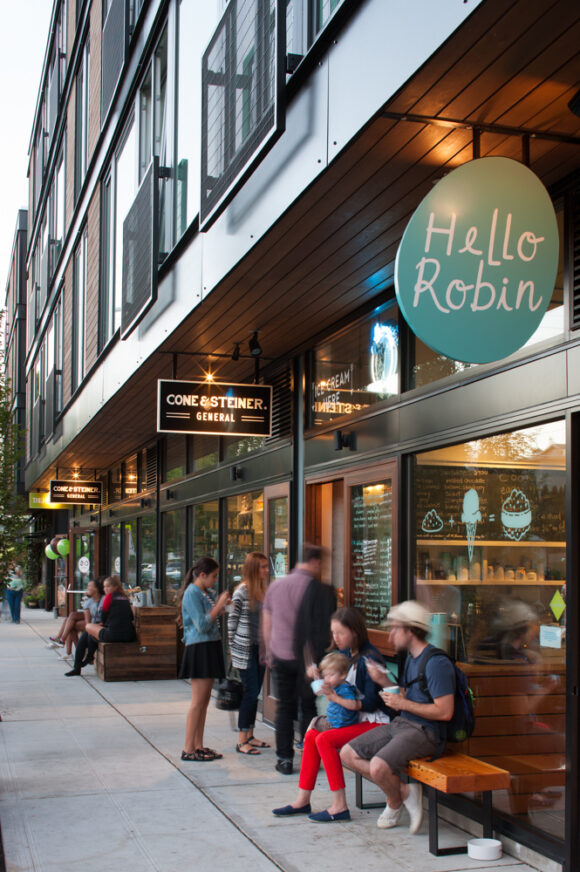 PF: Linda is really cool, and she’s become a friend since the conception of 19th& Mercer. When we were planning the project, we always came back to the idea that the corner retail space was the building’s highest priority. We were working with a great architect, Weinstein A|U, so we weren’t as concerned about the design of the apartments on the upper floors. The corner space had to be something special, so we set the building significantly back from the sidewalk to make room for a spacious patio, knowing that would be key to attracting the best tenant. We had Linda Derschang in mind from day one. In fact, we weren’t really interested in any other business owners. We knew that if Linda opened a restaurant and bar there, it would give the location credibility; she has such great style and always seems to know the right thing to do with a space. We also knew that if Linda were in the corner space, other quality local business owners would come. It has been really fun getting to know Robin Wehl of Hello Robin, Molly Moon of Molly Moon’s Homemade Ice Cream, Tierany Slater of The Herbalist, and Dani Cone of Cone & Steiner, all of whom are terrific tenants in the building.
PF: Linda is really cool, and she’s become a friend since the conception of 19th& Mercer. When we were planning the project, we always came back to the idea that the corner retail space was the building’s highest priority. We were working with a great architect, Weinstein A|U, so we weren’t as concerned about the design of the apartments on the upper floors. The corner space had to be something special, so we set the building significantly back from the sidewalk to make room for a spacious patio, knowing that would be key to attracting the best tenant. We had Linda Derschang in mind from day one. In fact, we weren’t really interested in any other business owners. We knew that if Linda opened a restaurant and bar there, it would give the location credibility; she has such great style and always seems to know the right thing to do with a space. We also knew that if Linda were in the corner space, other quality local business owners would come. It has been really fun getting to know Robin Wehl of Hello Robin, Molly Moon of Molly Moon’s Homemade Ice Cream, Tierany Slater of The Herbalist, and Dani Cone of Cone & Steiner, all of whom are terrific tenants in the building.
We immediately started working with Linda, getting her mentally invested in the project, and she helped us think through the design of Tallulah’s. Frankly, the overall look and feel of the building was something she played a key role in. While Linda isn’t an architect, she has really good instincts as a placemaker, and is an amazing self-taught designer. In fact, she is now working with us on our East Union project, collaborating with our interior designer to create the common spaces and shape the design of the units.
JF: When we first approached Linda, she said she didn’t want to be part of a new construction project—she couldn’t see herself in a new building. We asked: why not? We weren’t going to recreate a heritage brick building, but maybe we could incorporate some of the same warmth, natural materials and indoor-outdoor spaces that resonated with her. I think that was one of our biggest wins because we were successful in converting her thinking about new construction.
You recognize that bringing in the right establishments to ground floor retail spaces adds value to a project and benefits the living units and other shops. Why does it seem like most developers in town don’t get this correlation?
JF: It’s challenging. It’s either something that many developers aren’t interested in, or they don’t feel that they have time to address it. The usual catchall approach is to just hire a broker who will check the boxes—as long as their capital partners are in agreement. It’s not typical for most developers to think beyond the near term, in which case they miss out on how the project adds to the community, and how residents interact with it over time. The reality is that short-term thinking drives the market and most capital operates on a three- to five-year timeline, which ultimately informs how the development community functions.
PF: Whether we’re holding or selling, a project is a reflection of our work; each time we try and do a little better, think deeper about design, and bring in good neighborhood retail. We take pride in our work, and we plan to live in Seattle for the rest of our lives. We are concerned, however, that the City’s new fees on commercial space in all new buildings is going to make it more challenging for us to source local retail shops, bars, and restaurants in our projects.
Can you talk a bit about why you partially subsidize the retail spaces in your developments to secure the right businesses?
PF: These places are legacies that we create for neighborhoods. For example, at 19th& Mercer we had a verbal offer from a major coffee chain to take the space occupied by Tallulah’s for nearly double the rate per square-foot of where we began with Linda. Her rate was below market to start, and we increased it over the course of three or four years to get it closer to market, giving Linda the opportunity to establish Tallulah’s and grow her customer base without having to incur a higher rent to begin with. With the coffee chain, we would have had a boring cookie cutter business, and the neighborhood would have hated us for it.
JF: It was an opportunity to enliven the entire street. It’s about anchoring a neighborhood with something more special than a lobby with a coffee shop. We’ve had to pull many people though the mud on the importance of this type of thinking, and thankfully for our industry, we are starting to see other developers speak the same language.
Is this attitude of doing thoughtful work helpful in cultivating equity partners? Do they see the value in this?
JF: They don’t look at the quality of our work and decide to lower their investment returns in order to partner with us. There’s no direct economic benefit to doing more thoughtful work. But at the same time, they’re excited to do more business, the relationship becomes more programmatic, and we get repeat investment. Our reputation in places like Seattle and Portland can also help us establish relationships and close deals.
Given your research, how can developers create housing that is more accessible and affordable?
JF: We’re still brainstorming about how we can deliver mixed-income buildings. The system just isn’t well set up for it. Because of the way the government grants dollars, whether at the federal, state or city levels, and the way for-profit lenders require collateral, the two ends don’t seem to meet. So the first step for us has been to figure out how to bring them together.
PF: It’s difficult to create affordable housing under the current system, especially given the high cost of building. Our Rooster project offers a good example of how municipal costs can get out of control and impact affordability. We had to temporarily move the power lines across the street to allow the construction crane clearance, and Seattle City Light charged us $100,000 for six to eight hours of time to relocate the lines. We recognize that there are other costs outside of the time spent to move the power lines, but these fees are excessive. We are all for being reasonable, but this is just one small example of the costs incurred on a project, which ultimately leads to higher rents, to some degree. We would love to be in a position to charge less rent, and yes, we’re looking for modest returns to justify our projects—but if costs were lower, rents could be lower. Affordable housing developers are dealing with these same issues.
I recently got to know some of the people at Mercy Housing. They’re trying to provide true low-income housing, and they don’t get any sort of break from the City on fees such as power line relocation. From my point of view, they ought to be eligible for streamlined design review. There needs to be some meaningful relief the City can offer developers, be they for-profit or non-profit, for affordable housing.
JF: I think the HALA (Housing Affordability and Livability Agenda) recommendations are fantastic. We should pursue them and not get distracted by any of the feel-good policy that is otherwise out there to thwart it.
 Joe Ferguson leads Lake Union Partner’s acquisition and capital development efforts, and guides the firm in creating effective real estate investment opportunities. Joe serves on the National Advisory Board for the University of Colorado Real Estate Center.
Joe Ferguson leads Lake Union Partner’s acquisition and capital development efforts, and guides the firm in creating effective real estate investment opportunities. Joe serves on the National Advisory Board for the University of Colorado Real Estate Center.
 Pat Foley manages and oversees development for Lake Union Partners, focuses on placemaking, is active in the entitlement process, and maintains investment partner relations
Pat Foley manages and oversees development for Lake Union Partners, focuses on placemaking, is active in the entitlement process, and maintains investment partner relations






